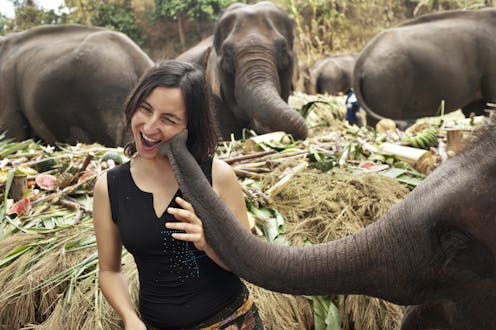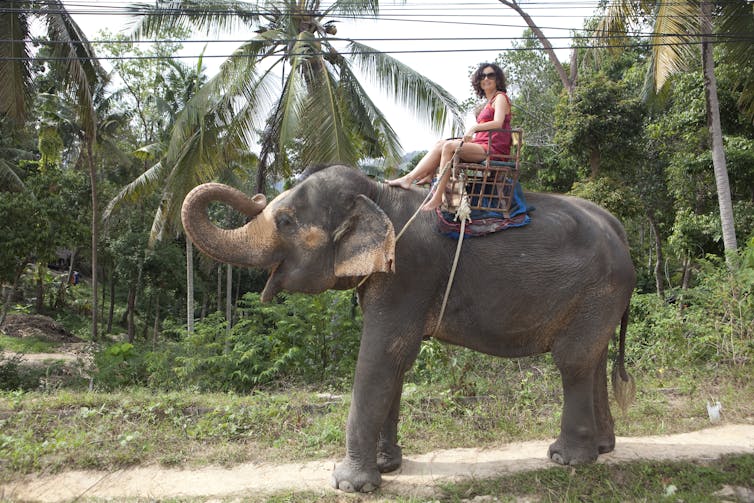Elephant tourism often involves cruelty – here are steps toward more humane, animal-friendly excursi
Even self-proclaimed ethical tourism programs can widen economic gaps and harm communities they claim to protect. Here are a few steps you can take as an ethical tourist.

Suju Kali is a 50-year-old elephant in Nepal who has been carrying tourists for over 30 years. Like many elephants I encounter through my research, Suju Kali exhibits anxiety and can be aggressive toward strangers. She suffers from emotional trauma as a result of prolonged, commercial human contact.
Like Suju Kali, many animals are trapped within the tourism industry. Some venues have no oversight and little concern for animal or tourist safety. Between 120,000 and 340,000 animals are used globally in a variety of wildlife tourism attractions, including endangered species like elephants. Over a quarter of the world’s endangered elephants reside in captivity with little oversight.
Wildlife tourism – which involves viewing wildlife such as primates or birds in conservation areas, feeding or touching captive or “rehabilitated” wildlife in facilities, and bathing or riding animals like elephants – is tricky business. I know this because I am a researcher studying human relationships with elephants in both tourism and conservation settings within Southeast Asia.
These types of experiences have long been an extremely popular and profitable part of the tourism market. But now, many travel-related organizations are urging people not to participate in, or calling for an outright ban on, interactive wildlife experiences.
Tourism vendors have started marketing more “ethical options” for consumers. Some are attempting to truly improve the health and welfare of wildlife, and some are transitioning captive wildlife into touch-free, non-riding or lower-stress environments. In other places, organizations are attempting to implement standards of care or create manuals that outline good practices for animal husbandry.
This marketing, academics argue, is often simply “greenwashing,” applying marketing labels to make consumers feel better about their choices without making any real changes. Worse, research shows that some programs marketing themselves as ethical tourism may instead be widening economic gaps and harming both humans and other species that they are meant to protect.
No quick fix
For example, rather than tourist dollars trickling down to local struggling families as intended by local governments, many tourism venues are owned by nonresidents, meaning the profits do not stay in the area. Likewise, only a small number of residents can afford to own tourism venues, and venues do not provide employment for locals from lower income groups.
This economic gap is especially obvious in Nepalese elephant stables: Venue owners continue to make money off elephants, while elephant caregivers continue to work 17 hours a day for about US$21 a month; tourists are led to believe they are “promoting sustainability.”
Yet, there are no easy answers, especially for elephants working in tourism. Moving them to sanctuaries is difficult because with no governmental or global welfare oversight, elephants may end up in worse conditions.
Many kindhearted souls who want to “help” elephants know little about their biology and mental health needs, or what it takes to keep them healthy. Also, feeding large animals like Suju Kali is pricey, costing around $19,000 yearly. So without profits from riding or other income, owners – or would-be rescuers – can’t maintain elephants. Releasing captive elephants to the jungle is not a choice – many have never learned to live in the wild, so they cannot survive on their own.
Hurting local people
Part of the problem lies with governments, as many have marketed tourism as a way to fund conservation projects. For example in Nepal, a percentage of ticket sales from elephant rides are given to community groups to use for forest preservation and support for local families.
Increasing demand for wildlife-based tourism may increase traffic in the area and thus put pressure on local governments to further limit local people’s access to forest resources.
This may also lead to increased demands on local communities, as was the case in Nepal. In the 1970s, the Nepalese government removed local people from their lands in what is now Chitwan National Park as part of increasing “conservation efforts” and changed the protected area’s boundaries. Indigenous “Tharu,” or people of the forest, were forced to abandon their villages and land. While some were offered access to “buffer zones” in the 1990s, many remain poor and landless today.
In addition, more and more desirable land surrounding conservation areas in Nepal is being developed for tourist-based businesses such as hotels, restaurants and shops, pushing local poor people farther away from central village areas and the associated tourism income.

Some activists would like humans to simply release all wildlife back into the wild, but there are multiple issues with that. Elephant habitats throughout Southeast Asia have been transformed into croplands, cities or train tracks for human use. Other problems arise from the fact that tourism elephants have never learned how to be elephants in their natural elements, as they were separated from their herds at an early age.
So tourism may be vital to providing food, care and shelter to captive elephants for the rest of their lives and providing jobs for those who really need them. Because elephants can live beyond 60 years, this can be a large commitment.
How to be an ethical tourist
To protect elephants, tourists should check out reviews and photos from any venue they want to visit, and look for clues that animal welfare might be impacted, such as tourists allowed to feed, hold or ride captive wildlife animals. Look for healthy animals, which means doing research on what “healthy” animals of that species should look like.
If a venue lists no-touch demonstrations – “unnatural” behaviors that don’t mimic what an elephant might do of their own accord, such as sitting on a ball or riding a bike, or other performances – remember that the behind-the-scenes training used to achieve these behaviors can be violent, traumatic or coercive.
Another way to help people and elephant is to to use small, local companies to book your adventures in your area of interest, rather than paying large, international tourism agencies. Look for locally owned hotels, and wait to book excursions until you arrive so you can use local service providers. Book homestay programs and attend cultural events led by community members; talk to tourists and locals you meet in the target town to get their opinions, and use local guides who provide wildlife viewing opportunities while maintaining distance from animals.
Or tourists can ask to visit venues that are certified by international humane animal organizations and that do not allow contact with wildlife. Or they can opt for guided hikes, canoe or kayak experiences, and other environmentally friendly options.
While these suggestions will not guarantee that your excursion is animal-friendly, they will help decrease your impact on wildlife, support local families and encourage venues to stop using elephants as entertainment. Those are good first steps.
Michelle Szydlowski does not work for, consult, own shares in or receive funding from any company or organization that would benefit from this article, and has disclosed no relevant affiliations beyond their academic appointment.
Read These Next
Christmas trees are more expensive than ever in Colorado — what gives?
Most Christmas trees are imported from other states, which drives up costs.
How the NIH became the backbone of American medical research and a major driver of innovation and ec
The agency’s budget has grown steadily since the 1960s, fueling an industry that creates lifesaving…
Pandas, pingpong and ancient canals: President Xi’s hosting style says a lot about Chinese diplomacy
During a recent visit to China, French President Emmanuel Macron was given the diplomatic works.





